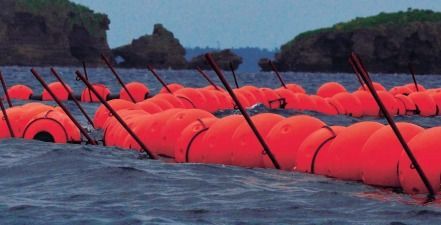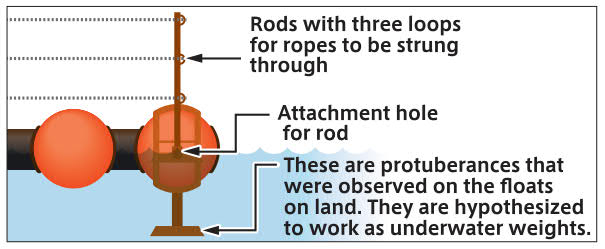MOD installs new above-water fencing to keep protest boats out of Henoko construction zone

The new floats have rods with three loops on each for ropes to be strung through. This picture was taken on January 14 at Oura Bay in Henoko, Nago.
On January 14, the Okinawa Defense Bureau (ODB) of the Ministry of Defense began to install new floats with protuberances on the ocean in relation to the Futenma Air Station relocation plan and the plan to construct a new base in Henoko, Nago. These floats, prepared by the ODB, have protruding rods that appear to be metal. Rope is strung between these rods, which stick up above the water. It seems that these floats are being used as an above-water fence to keep out citizens’ protest boats and canoes. If citizens cut these ropes, the Japan Coast Guard could potentially make a property damage cases against the perpetrators.

These new floats have protuberances that sit underwater. Because the protuberances, to which plates and rods are attached, cannot be seen above the water, it appears they are being used as weights beneath the water. Upward rods are erected about three flotation spheres apart from each other, and each has three loops through which rope can be strung parallel to the surface of the water.
People are voicing their concerns about the metal rods, pointing out that they pose dangers to citizens opposing base construction in Henoko. Criticism against the Japanese government’s unbending stance toward hastening construction seems to be piling up.
When asked about the use of the new floats in an interview with Ryukyu Shimpo on January 12, the ODB answered that the floats are for no other purposes than to mark the boundary of a temporarily restricted area and absolutely ensure work safety. The ODB did not clarify the purpose of the above-water fencing or other specifics.
Past 3:00 p.m. on January 14 the OBD had set up three strands of the new floats, each of which measures about 100 meters in length. The floats were attached by wire to large, submerged concrete blocks. At that time there were still many floats remaining on the sandy beach, and more being brought in by truck. It appeared that installation work of the above-water fencing would continue into the next day.
Citizens took 3 protest boats, 1 inflatable boat, and 11 canoes out to protest on January 14. The Japan Coast Guard restrained one protest boat for a short duration. Starting at 7:00 a.m. on the same day, citizens engaged in a sit-in protest against construction of a new base near Camp Schwab’s gate in Henoko, Nago. At most about 90 people participated in the gate-front protest.
(English translation by T&CT and Erin Jones)
Previous Article:Okinawa Plans 40 country, 700 participant International Karate Tournament for the summer of 2018
Next Article:Governor Onaga to visit US to lobby Trump administration on base issue
[Similar Articles]
- JCG’s craft hits rubber boat carrying Henoko protesters
- Citizens protesting in Oura Bay ask for understanding that they do not want Henoko base
- Citizens call “protect the coral” from 70 canoes and 9 boats to protest Henoko base
- Floats positioned on Oura Bay after 50 people protested against Henoko base
- 150 citizens hold on-water protest against Henoko base marking one year since embankment work began
 Webcam(Kokusai Street)
Webcam(Kokusai Street)


